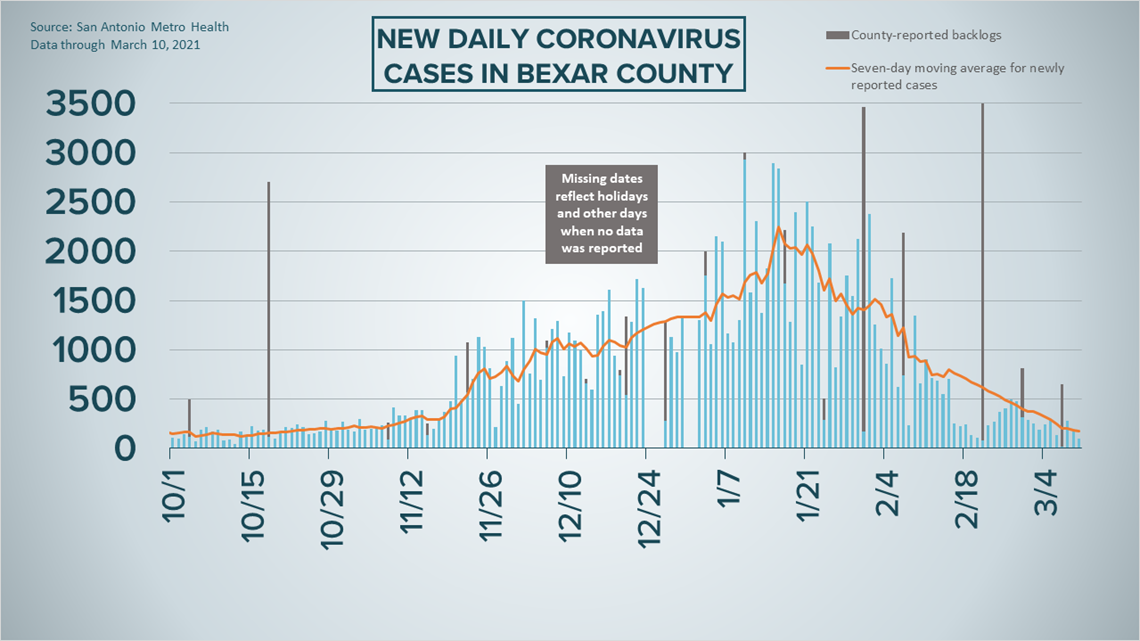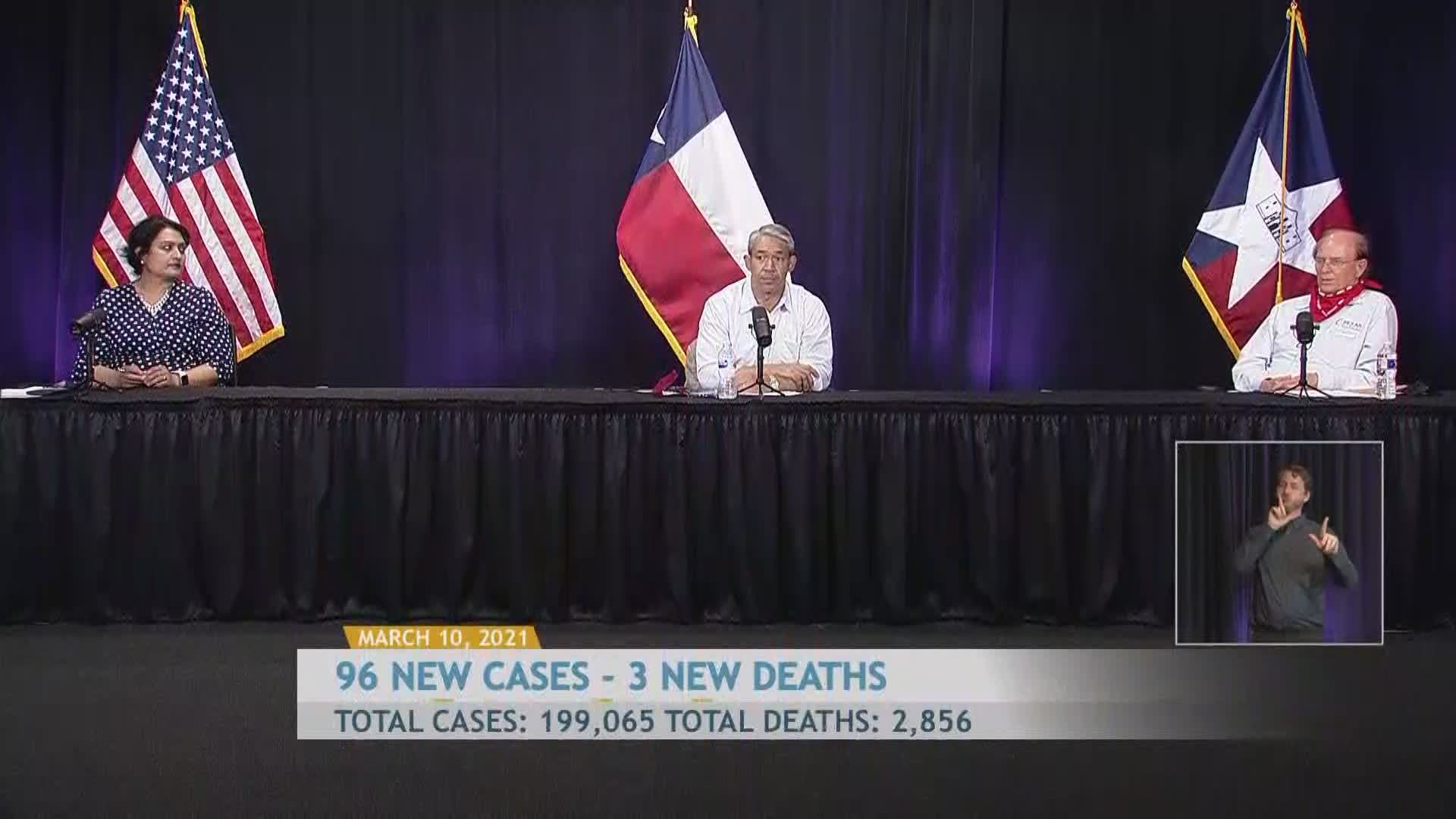SAN ANTONIO — We're tracking the latest numbers from the coronavirus pandemic in San Antonio and across Texas. Here are the latest numbers reported by Bexar and surrounding counties:
- Bexar County: On Wednesday, 96 new cases were reported, bringing the total number of cases to 199,065. Three deaths were reported, raising the local death toll from virus complications to 2,856.
- Hays County: On Wednesday, officials reported 23 new cases in the county and no additional COVID-related fatalities. There is now a total of 16,615 lab-confirmed local cases, while the death toll remained at 229. Officials estimate 15,887 residents have recovered, while 499 are still ill with the virus.
- Comal County: Officials reported 22 new cases on Wednesday, along with no additional virus-related deaths. As of Wednesday, 9,368 total COVID-19 cases have been reported, including 4,937 confirmed and 4,411 probable cases, while 298 county residents have died due to COVID-19 complications.
More county case information is available through the Texas Department of Health Services COVID-19 dashboard.
How Bexar County is trending
We've tracked how many coronavirus cases have been confirmed in Bexar County from the time officials began reporting cases in March 2020. The graphic below shows the number of cases since June and charts those daily case numbers along a 7-day moving average to provide a more accurate picture of the overall coronavirus case curve in our area and the direction we're trending amid the pandemic.
On Wednesday, San Antonio Mayor Ron Nirenberg reported 96 additional coronavirus cases in Bexar County, raising the local total to 199,065 cases since the pandemic began. The seven-day rolling case average continues to decrease, this time to 173, its lowest mark since October 23.
Nirenberg also reported three more virus-related deaths. In all, 2,856 Bexar County residents have died from coronavirus complications.


Hospitalizations continued to fall in Bexar County on Wednesday, decreasing by 12 to 250 COVID-19 patients at area hospitals. It's the lowest that number has been since November 3. 34 new admissions in the last 24 hours
Of those 250 patients, 73 are using ventilators and 112 are in intensive care.
Coronavirus in Texas
The total number of novel coronavirus cases in the state since the pandemic began grew by 4,863 on Wednesday, according to the Texas Department of State Health Services. That total includes 3,104 new confirmed cases, 1,306 new probable cases, and a backlog of 453 cases. More details can be found on this page.
Wednesday's figures bring the total number of Texans diagnosed with COVID-19 to more than 2.699 million.


Meanwhile, state health authorities reported an additional 225 deaths from coronavirus complications in Texas. In all, 44,875 Texans have died from COVID-19.
After statewide hospitalizations jumped by 373 Tuesday, that number decreased by 146 to 4,556 COVID-19 patients receiving treatment for their symptoms across the state.
The state, meanwhile, estimates that about 2.526 million Texans have recovered, while 125,403 Texans remain ill with COVID-19.
The latest update from the Texas Education Agency showed that there have been at least 190,308 cumulative cases among staff and students on Texas public school campuses through Feb. 28. That number comprises 123,875 positive student cases and 66,433 staff cases. More information can be found here.
The TEA typically releases new data on school cases on Fridays.
Latest Coronavirus Headlines
- How much will your stimulus payment be? This calculator can help
- Phase 1C starts March 15 with people 50 and older eligible for vaccine
- Texas attorney general promises lawsuit to stop Austin from enforcing mask mandate
- Wear The Gown: Why it is still important to wear a mask
- Key moments that defined the first year of the COVID-19 pandemic
- VERIFY: COVID-19 vaccines for zoo animals have no impact on human shot distribution
- Nursing home residents are now able to get hugs, federal government says
- President Biden announces plan to buy 100 million more Johnson & Johnson vaccines
Coronavirus symptoms
The symptoms of coronavirus can be similar to the flu or a bad cold. Symptoms include fever or chills, cough, shortness of breath or difficulty breathing, fatigue, muscle or body aches, headache, new loss of taste or smell sore throat, congestion or runny nose, nausea or vomiting, and diarrhea, according to the Centers for Disease Control.
Most healthy people will have mild symptoms. A study of more than 72,000 patients by the Centers for Disease Control in China showed 80 percent of the cases there were mild.
But infections can cause pneumonia, severe acute respiratory syndrome, kidney failure, and even death, according to the World Health Organization. Older people with underlying health conditions are most at risk.
Experts determined there was consistent evidence these conditions increase a person's risk, regardless of age:
- Chronic kidney disease
- COPD (chronic obstructive pulmonary disease)
- Obesity (BMI of 30 or higher)
- Immunocompromised state (weakened immune system) from solid organ transplant
- Serious heart conditions, such as heart failure, coronary artery disease, or cardiomyopathies
- Sickle cell disease
- Type 2 diabetes
The CDC believes symptoms may appear anywhere from two to 14 days after being exposed.
Human coronaviruses are usually spread...
- Between people who are in close contact with one another (within about 6 feet).
- Through respiratory droplets produced when an infected person coughs, sneezes or talks. These droplets can land in the mouths or noses of people who are nearby or possibly be inhaled into the lungs.
- Some recent studies have suggested that COVID-19 may be spread by people who are not showing symptoms.
Help stop the spread of coronavirus
- Stay home when you are sick.
- Eat and sleep separately from your family members
- Use different utensils and dishes
- Cover your cough or sneeze with your arm, not your hand.
- If you use a tissue, throw it in the trash.
Find a Testing Location
City officials recommend getting a COVID-19 test if you experience fever or chills, cough, shortness of breath or difficulty breathing, fatigue, muscle or body aches, headache, new loss of taste or smell, sore throat, congestion or runny nose, nausea or vomiting, or diarrhea.
A self-screening tool is available to see if you need a test.
Here's a Testing Sites Locator to help you find the testing location closest to you in San Antonio.

